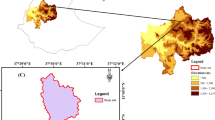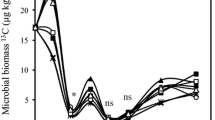Abstract
Little information is available on soil respiration and microbial biomass in soils under agroforestry systems. We measured soil respiration rate and microbial biomass under two age classes (young and old) of a pecan (Carya illinoinensis) — cotton (Gossypium hirsutum) alley cropping system, two age classes of pecan orchards, and a cotton monoculture on a well-drained, Redbay sandy loam (a fine-loamy, siliceous, thermic Rhodic Paleudult) in southern USA. Soil respiration was quantified monthly during the growing season from May to November 2001 using the soda-lime technique and was corrected based on infrared gas analyzer (IRGA) measurements. The overall soil respiration rates ranged from 177 to 776 mg CO2 m−2 h−1. During the growing season, soil respiration was higher in the old alley cropping system than in the young alley cropping system, the old pecan orchard, the young pecan orchard, and the monoculture. Microbial biomass C was higher in the old alley cropping system (375 mg C kg−1) and in the old pecan orchard (376 mg C kg−1) compared to the young alley cropping system (118 mg C kg−1), young pecan orchard (88 mg C kg−1), and the cotton monoculture (163 mg C kg−1). Soil respiration was correlated positively with soil temperature, microbial biomass, organic matter, and fine root biomass. The effect of alley cropping on soil properties during the brief history of alley cropping was not significant except in the old systems, where there was a trend of increasing soil respiration with short-term alley cropping. Over time, different land use and management practices influenced soil properties such as soil temperature, moisture, microbial biomass, organic matter, and fine root biomass, which in turn affected the magnitude of soil respiration. Our results suggest that trees in agroforestry systems have the potential to enhance soil fertility and sustainability of farmlands by improving soil microbial activity and accreting residual soil carbon.
Similar content being viewed by others
References
Amatya. G., Chang S.X., Beare M.H. and Mead D.J. 2002. Soil properties under a Pinus radiata - ryegrass silvopastoral system in New Zealand. Part II. C and N of soil microbial biomass, and soil N dynamics. Agrofor Syst 54: 149–160.
Buchmann N. 2000. Biotic and abiotic factors controlling soil respiration rates in Picea abies stands. Soil Biol Biochem 32: 1625–1635.
Dictor M.C., Tessier L. and Soulas G. 1998. Reassessement of the K EC coefficient of the fumigation-extraction method in a soil profile. Soil Biol Biochem 30: 119–127.
Edwards N.T. 1982. The use of soda-lime for measuring respiration rates in terrestrial systems. Pedobiologia 23: 321–330.
Ewel K.C., Cropper W.P. and Gholz H.L. 1987. Soil CO2 evolution in Florida slash pine plantations. I. Changes through time. Can J For Res 17: 325–329.
Fahey T.J. and Hughes J.W. 1994. Fine root dynamics in a northern hardwood forest ecosystem. Hubbard Brook Experimental Forest, NH. J. Ecol. 82: 533–548.
Fang C., Moncrieff J.B., Gholz H.L. and Clark K.L. 1998. Soil CO2 efflux and its spatial variation in a Florida slash pine plantation. Plant Soil 205: 135–146.
Franzluebbers A.J., Hons F.M. and Zuberer D.A. 1995. Tillage and crop effect on seasonal dynamics of soil CO2 evolution, water content, temperature, and bulk density. Appl Soil Ecol 2: 95–109.
Haynes B.E. and Gower S.T. 1995. Beloground carbon allocation in unfertilized and fertilized red pine plantations in northern Wisconsin. Tree Physiol 15: 317–325.
Jose S., Gillespie R, Seifert J.R., Mengel D.B. and Pope P.E. 2000. Defining competition vectors in a temperate alley cropping system in the Midwestern USA. 3. Competition for nitrogen and litter decomposition dynamics. Agrofor Syst 48: 61–77.
Kelting D.L., Burger J.A. and Edwards G.S. 1998. Estimating root respiration, microbial respiration in the rizosphere, and rootfree soil respiration in forest soils. Soil Biol Biochem 30: 961–968.
Kort J. and Turnock R. 1999. Carbon reservoir and biomass in Canadian prairie shelterbelts. Agrofor Syst 44: 175–186.
Lloyd J. and Taylor J.A. 1994. On the temperature dependence of soil rspiration. Func Ecol 8: 315–323.
Mallik A.U. and Hu D. 1997. Soil respiration following site preparation treatments in boreal mixedwood forest. For Ecol Manage 97: 265–275.
Moore J.M., Klose S. and Tabatabai M.A. 2000. Soil microbial biomass carbon and nitrogen as affected by cropping systems. Biol Fertil Soils 31: 200–210.
Nair P.K.R. and Nair V.D. 2003. Carbon storage in North American Agroforestry Systems. In: Kimble J.M., Heath L.S., Birdsey R.A. and Lal R. (eds), The Potential of U.S. Forest Soils to Sequester Carbon and Mitigate the Greenhouse Effect. CRC Press, Boca Raton, Florida, USA, pp. 333–346.
Nay S.M., Mattson K.G. and Bormann B.T. 1994. Biases of chamber methods for measuring soil CO2 efflux demonstrated with a laboratory apparatus. Ecol 75: 2460–2463.
Palm C.A. 1995. Contribution of agroforestry trees to nutrient requirements of intercropped plants. Agrofor Syst 30: 105–124.
Raich J.W. and Schlesinger W.H. 1992. The global carbon dioxide flux in soil respiration and its relationship to vegetation and climate. Tellus 44B: 81–99.
Raich J.W. and Tufekcioglu A. 2000. Vegetation and soil respiration: Correlations and controls. Biogeochem 48: 71–90.
Ross D.J., Tate K.R., Scott N.A. and Feltham C.W. 1999. Landuse change: effects on soil carbon, nitrogen and phosphorus pools and fluxes in three adjacent ecosystems. Soil Biol Biochem 31: 803–813.
SAS Institute Inc. 1990. SAS user's guide: Statistics. SAS Institute Inc., Cary, NC 0: 0.
Stoyan H., De-Polli H., Bohm S., Robertson G.P. and Paul E.A. 2000. Spatial heterogeneity of soil respiration and related properties at the plant scale. Plant Soil 222: 203–214.
Tufekcioglu A., Raich J.W., Isenhart T.M. and Schultz R.C. 2001. Soil respiration within riparian buffers and adjacent crop fields. Plant Soil 299: 117–124.
Vance E.D., Brookes P.C. and Jenkinson D.S. 1987. An extraction method for measuring microbial biomass C. Soil Biol Biochem 19: 703–707.
Wagai R., Brye K.R., Gower S.T., Norman J.M. and Bundy L.G. 1998. Land use and environmental factors influencing soil surface CO2 flux and microbial biomass in natural and managed ecosystems in southern Wisconsin. Soil Biol Biochem 30: 1501–1509.
Witter E., Martensson A.M. and Garcia F.V. 1993. Size of the soil microbial biomass in a long-term field experiment as affected by different N-fertilizers and organic manure. Soil Biol Biochem 25: 659–669.
Author information
Authors and Affiliations
Corresponding author
Rights and permissions
About this article
Cite this article
Lee, KH., Jose, S. Soil respiration and microbial biomass in a pecan — cotton alley cropping system in Southern USA. Agroforestry Systems 58, 45–54 (2003). https://doi.org/10.1023/A:1025404019211
Issue Date:
DOI: https://doi.org/10.1023/A:1025404019211




